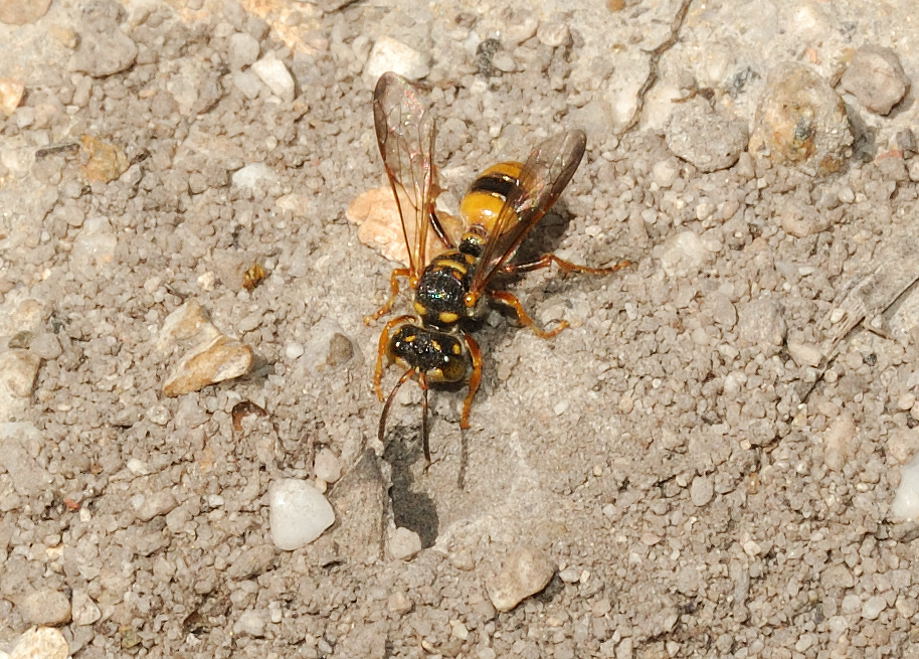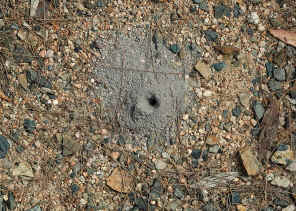|
| |
Family Crabronidae, subfamily Philanthinae
- This page contains pictures and information about Cerceris Digger Wasps that we
found in the Brisbane area, Queensland, Australia.
-
 - Body length 10mm
-
- Digger Wasp in subfamily Philanthinae is
medium in size . There is the petiole segment between the thorax and abdomen.
The abdomen is constricted between segments. The head is large and wide. The
hind legs, or femur, are expanded and flattened.
-
 
 -
- Digger wasps nest in bare, firm ground. They nest communally and there is
some division of labour. All Australian wasps in this subfamily are in Cerceris
genus.
-
First Encounter
- In summer 2006, when we were looking for the Bembix
nests, we found some smaller wasp nests in Karawatha Forest on bare sandy
ground next to a foot track. We found at least four nests in the area. More
than at least one wasp living in the same nest or using the same nest entry.
Because we could not see the whole insect. We did hot exactly know what they
were.
-
 
 -
-
-
- The wasps do not close the entry. A wasp was always guarding at the entry. Within our 10 minutes watching, we
saw one wasp fly out from the nest. We did not saw any wasp fly in except the
one with prey trying to enter, mentioned below.
-

  -
- We found two nests near the sand patch where we were looking for the
Bembix. They were about ten meters apart. The entry was a small hole with 6mm in
diameter. The entry was a dome of loose soil with diameter 80mm and 40mm
height.
-
  -
- A wasp carrying a prey was coming back to the nest. Because we were inspecting the nest, it just rested on a small plant and
waited. When we came
close to it, it dropped the prey and flied away. The wasp was about 10mm in body
length, with lemon-yellow and black body patterns. The prey was a small beetle
(family Cleridae), 5mm body length, It was metallic brown in colour. It was paralyzed,
but it legs still moved.
-

 -
- We waited for the whole afternoon and seldom saw them going in and out. When
they did, they did it very quickly. We could not take any photos good enough to identify
them. The above second
photo was out of focus but it is the only full body photo that we took. We
took this photo by ticking the guarding wasp came out of the nest (somewhat
like fishing), then quick blocked the entry by a dry leaf. Anyway, the wasp
went back into the nest within 10 seconds.
-
Finally found out who they are
- In early summer 2007, we went back to the site again. We waited for an
hour and we took the following photos.
-
-



-
- From those photos we finally confirmed that this wasp is the Cerceris
sp.
-
- Reference:
- 1. Insects
of Australia, CSIRO, Division of Entomology, Melbourne University
Press, 2nd Edition 1991, pp 993.
- 2. Insects of Australia and New Zealand - R. J. Tillyard, Angus
& Robertson, Ltd, Sydney, 1926, p299.
[ Up ] [ Cerceris Digger Wasp 1 ] [ Cerceris Digger Wasp 3 ] [ Cerceris Digger Wasp 4 ]
| |
|

















